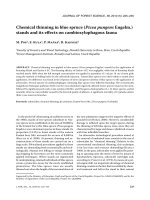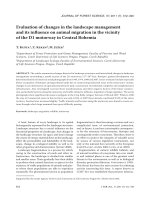Financial management system of vietnam posts and telecommunications group and its effects on financial efficiency of the company
Bạn đang xem bản rút gọn của tài liệu. Xem và tải ngay bản đầy đủ của tài liệu tại đây (83.92 KB, 14 trang )
THAI NGUYEN UNIVERSITY
SOUTHERN LUZON STATE UNIVERSITY
Socialist Republic of Viet Nam
Republic of Philippines
TO THI NGOC LAN
(ENGLISH NAME: JENNY)
FINANCIAL MANAGEMENT SYSTEM OF VIETNAM POSTS AND
TELECOMMUNICATIONS GROUP AND ITS EFFECTS ON FINANCIAL
EFFICIENCY OF THE COMPANY
DOCTORAL DISSERTATION ABSTRACT
ADVISER: DR. JOANNA PAULA A. ELLAGA
AUGUST, 2013
ABSTRACT
In the background of deeper and wider regional and international economic
integration, enterprises have to face with more formidable competition from big
multinational economic organizations in the world. In order to adapt to that situation,
many countries are incessantly increase scales of businesses, establishing and
developing economic groups. In order to ensure the high efficiency of those economic
groups and State owned enterprises, it is necessary to improve efficiency of financial
management system of economic groups.
With such an approach to issues, the main objectives of dissertation is study
the current status of system financial management of VNPT and its effect on financial
efficiency of company. In order to obtain main objectives of study, the researcher
used the descriptive method to get data which includes: Primary data was collected by
sending questionnaires to 169 respondents and secondary data: From the annual
financial reports of VNPT from 2010 to 2012. For assessing the current status of
VNPT’s financial management system, the dissertation focuses on studying the
profile and the formation and development process of VNPT as well as VNPT’s
regulations on capital mobilization, management and use of capital and assets,
management of revenues, expenses and profit distribution, thereby assessing financial
management system and its effects on VNPT’s financial efficiency from 2010 to
2012. All this proves that the financial management system of VNPT effects
positively to financial efficiency of the Group.
2
CHAPTER I:
INTRODUCTION
There are many studies about financial management system in economic
groups under the eyes of theory, situation evaluation as well as summary of
experience in the country and foreign countries. Followings are typical ones:
Firstly, the study, which was published into book, has title: “Business Groups
and financial management system in Business Groups” published in 2003, by author
Pham Quang Trung. This study shows many basic theoretical matters about financial
management system in economic groups, State owned enterprises as well as
descriptions, summaries, analysis of overall picture of actual situation of applying
financial management system in economic groups, State owned enterprises in Vietnam
in the first period when economic groups, State owned enterprises started to go into
operation.
Secondly, the study under form of textbook has title “Financial management of
modern enterprises” published in 2009, author Duong Huu Hanh. This study, although
not directly mentioning words “financial management system in economic groups”,
has contents of financial management in modern enterprises under the view of
financial management of enterprises.
Thirdly, the study “Establishment and management of business Groups in
VietNam” in 1996 and the author Nguyen Dinh Phan. In this study, the author has
written few pages of financial management in business groups; however, to some
extent, the content about this issue is limit and suggestive.
Generally, about financial management system in the economic groups in
Vietnam, there are some works under the form of books which mention different
3
angles, but all were released from the 2000 onwards. Nowadays under the impact of
regional and international economic integration, and the management of the State for
State economic groups inevitably arises many new issues in the financial management
system of economic groups in VietNam.
1.1. Statement of the objectives
This study intended to analysis of financial management system of VNPT and
its effects on financial efficiency of the Group. Specifically, the specific objectives of
this study are:
(1) To identify the profile of the company in terms of the following: Type of
the company and Size of the company; (2) To determine the current status of financial
management system of VNPT in terms of the following: Capital mobilization, Capital
management and use, Asset management, Management of revenue, expense and profit
distribution; (3) To assess the financial efficiency of VNPT in terms of the following
financial ratios: the asset turnover ratio and the debtor days ratio; (4) To determine the
effects of the financial management system to the financial efficiency of VNPT; (5)
To identify the problems encountered in carrying out the financial management
system of VNPT; (6) To propose actions that will respond to the problems
encountered in carrying out the financial management system of VNPT.
1.2. Significance of the Study
This research will be beneficial for the following:
Investors take an interest in information about the financial efficiency
of VNPT. On the one hand, they want to obtain the adequate amount of information
needed for decision-making about investments in the Group. On the other hand,
owners and investors want to make sure whether invested resources are properly
evaluated and optimized.
4
Managers need to know about financial management for current and longterm decisionmaking.
Employees are naturally interested in prosperity, economic and financial
stability of VNPT. It is concerned with job security, possibilities in wage and social
policy, or other benefits provided by the employer.
For researcher, provide theoretical knowledge of the financial management
system of economic groups in general and VNPT in particular.
1.3. Scope and limitation of the Study
The study of current status of financial management system in VNPT is
performed from 2010 to 2012.
In my case, Financial efficiency, viewed as dependent variables.
Accounting information system practices; Financial reporting and analysis
practices; Capital structure management practices; Capital mobilization practices;
Capital management and use practices; Asset management practices; Revenue,
expense and profit distribution management practices, viewed as independent
variables.
But time and my ability is limited, I will focus on: Capital mobilization
practices; Capital management and use practices; Asset management practices;
Revenue, expense and profit distribution management practices, viewed as
independent variables.
5
CHAPTER II:
RELATED LITERATURE
2.1. Review of related studies
In this chapter, the author presented some related studies.
2.2. Theoretical and conceptual framework
In this part, the author presented definition of finance, contents of financial
management system, factors influencing financial management system, criteria for
financial efficiency evaluation of financial management system and definition of
financial efficency.
2.3. Research Paradigm
6
FINANCIAL MANAGEMENT SYSTEM OF VNPT AND ITS EFFECTS
ON FINANCIAL EFFICIENCY OF THE COMPANY
Independent Variable
Dependent Variable
Company profile
Type of company
Size of company
Current status of financial
management system
Financial Efficiency
Capital mobilization
Capital management
and use
Asset management
Management of
revenue, expense and
profit distribution
Problems encountered
7
CHAPTER III:
METHODOLOGY
3.1. Data collection method
- Primary data was collected by sending questionnaires to 169 respondents
(CFO of VNPT, director of financial department of VNPT, deputy director of
financial department of VNPT, CFO of VNPT’s subsidiaries) working in VNPT and
its subsidiaries.
- Secondary data: From the annual financial reports of VNPT from 2010 to
2012.
3.2. Data processing method
After information is collected, information in the questionnaire will be cleaned
and processing by SPSS 16.0.
3.3. Statistical treatment
This study used statistical methods to process data analysis as indicates.
The asset turnover ratio
Sales Revenue
The asset
=
turnover ratio
Net Assets
The debtor days ratio
Debtors
The debtor
=
days ratio
x
365
Sales turnover
8
CHAPTER IV:
PRESENTATION, ANALYSIS AND INTERPRETATION OF DATA
In the chapter 4 of this dissertation, the first the author focused on analyzing
the current status of financial management systems and its impact to the financial
efficiency of VNPT in the period 2010 - 2012. Capital mobilization of VNPT both
ensure the autonomy and the security. The financial management system created new
initiative in capital mobilization helping to address shortage of capital in the context
of capital scarcity as currently. Capital management and use in VNPT are rather strict,
not only facilitating to increase the self-control, self-responsibility of VNPT but also
strengthening examination, supervision on Representative owners of State capital.
Asset management of the VNPT has relatively clear separation between ownership
and rights to use assets. Management of revenue, expense and profit distribution is
quite clear, explicit to ensure balance between benefit of State, cooperation and
temporary and long-term benefit of workers, cooperation, contributing to encourage
for saving and to improve efficiency in production business at VNPT. Then, the
author make some evaluation about financial efficiency of VNPT.
4.1. Assess the financial efficiency of VNPT
The asset turnover ratio
This measures the productivity of the business. It is calculated using the
following formula:
Sales Revenue
The asset
=
turnover ratio
Net Assets
9
Table 1. The asset turnover ratio of VNPT from 2010 to 2012
Unit: Billion dongs
Year
2010
2011
2012
Sales Revenue
101,569
120,800
130,000
Net Assets
69,499
71,807
73,968
The asset turnover ratio
1.46
1.68
1.76
The debtor days ratio
This shows how long, on average, a business takes to collect the debts owed to
it by customers who have purchased their goods on credit. It is calculated using the
following formula:
Debtors
The debtor
=
days ratio
x
365
Sales turnover
Table 2. The debtor days ratio of VNPT from 2010 to 2012
Unit: Billion dongs
Year
2010
2011
2012
Debtors
13,003
14,737
15,193
Sales turnover
104,869
125,100
134,495
The debtor days ratio
45.26
43.0
41.23
4.2. Effects of the financial management system to the financial efficiency
of VNPT
Financial management system of VNPT has been conducted well so sales
revenue and net assets increased steadily from 2010 to 2012.
Sales revenue and net assets increased lead to the asset turnover ratio
increased. In 2010, the asset turnover ratio was 1.46; In 2011, the asset turnover ratio
10
was 1.68, increasing 15.068% compared with 2010; In 2012 the asset turnover ratio
was 1.76, increasing 4.762% compared to 2011.
The same, we see that financial management system of VNPT has been
conducted well so the debtor days ratio decreased steadily from 2010 to 2012.
In 2010, the debtor days ratio was 45.26 days; In 2011, the debtor days ratio was 43.0
days, decreasing 5.526% compared with 2010; In 2012 the debtor days ratio was
41.23 days, decreasing 4.293% compared to 2011.
All this proves that the financial management system of VNPT effects
positively to financial efficiency of the Group.
11
CHAPTER V:
CONCLUSIONS AND RECOMMENDATIONS
5.1. Summary of the findings
For current status of financial management system of VNPT
- Current status capital mobilization in VNPT
Capital mobilization of VNPT both ensure the autonomy and the security. The
financial management system created new initiative in capital mobilization helping to
address shortage of capital in the context of capital scarcity as currently.
- Current status capital management and use in VNPT
Generally, capital management and use in VNPT are rather strict, not only
facilitating to increase the self-control, self-responsibility of VNPT but also
strengthening examination, supervision on Representative owners of State capital.
- Current status of asset management in VNPT
Asset management of the VNPT has relatively clear separation between
ownership and rights to use assets.
- Current status of revenue, expense and profit distribution management in
VNPT
The managing revenue, cost and profit distribution is quite clear, explicit to
ensure balance between benefit of State, cooperation and temporary and long-term
benefit of workers, cooperation, contributing to encourage for saving and to improve
efficiency in production business at VNPT.
For effects of financial management system on financial efficiency of the
VNPT
12
Financial management system of VNPT has been conducted well so sales
revenue and net assets increased steadily from 2010 to 2012. It lead to the asset
turnover ratio increased and the debtor days ratio decreased.
All this proves that the financial management system of VNPT effects
positively to financial efficiency of the Group.
For the problem encountered by financial management system of VNPT
Firstly, capital mobilization of VNPT’s subsidiaries meet many difficult and
limited.
Secondly, investment out of
main business operations to VNPT without
efficiency.
Thirdly, although revenue of VNPT increase steadily from 2010 – 2012 but
profit of VNPT decrease.
5.2. Conclusions
- The assets and equity of VNPT had tended to increase over the years from
2010 to 2012.
- The rate of total payable liabilities over owner capital was 2.74 fold, 2.33
fold respectively in in 2011, 2012.
- The revenue of VNPT had tended to increase over the years from 2010 to
2012.
- But the profit of VNPT had tended to decrease over the years from 2010 to
2012.
5.3. Recommendations
Firstly, complete capital mobilization of VNPT’s subsidiaries
To extend the capital mobilization of VNPT, it is required to focus on handling
the main problems as follows:
13
- In general, perform the capitalization for VNPT and foster the listing in the
security market.
- For VNPT itself, set the instruction frame including: target, limit, loan
procedure… instead of approval for each case in the current time.
- Parallel with the extension of capital mobilization regime for subsidiaries of
VNPT, it is required to cooperate synchronously with the strengthening of
supervision, administration regime and the system of final criteria on effectiveness,
the extension of capital mobilization regime for member units under the Group can
become true and obtain the achievement as expected.
Secondly, complete investment out of main business operations
To correct the limitations of investment in the outside VNPT, it is required to
re-assess the capital, assets of VNPT accurately and re-structure the group toward
centralized objectives as increasing the financial efficiency of VNPT in new situation.
Raise the role in advising, moderating, supervising related parties to
investment decisions, project sponsorship and distribution polices in inner VNPT.
Thirdly, complete the management of revenue, expenses, and profit
distribution
- Complete the system of economic and technical regulations in compliance
with conditions, operating characteristics of VNPT both assuring the scientific and
actual requirements, innovation of plan making on revenue, cost for innovating the
ways of profit distribution in direction of focusing on long term benefit of VNPT.
- For the management of revenue, expenses and profit distribution, it is
required to focus on expense management because of only good management on
expenses and cost reduction results in extending the production and business and
increasing revenue and profit.
14









![thang nguyen ngoc - 2011 - corporate governance and its impact on the performance of firms in emerging countries - the evidence from vietnam [cg]](https://media.store123doc.com/images/document/2015_01/02/medium_rfd1420194809.jpg)